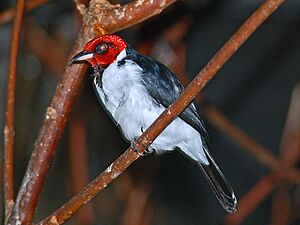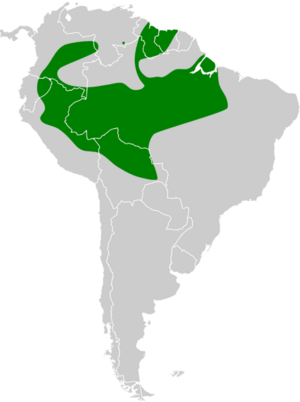Red-capped cardinal facts for kids
Quick facts for kids Red-capped cardinal |
|
|---|---|
 |
|
| Captive bird | |
| Conservation status | |
| Scientific classification | |
| Genus: |
Paroaria
|
| Species: |
gularis
|
 |
|
| Synonyms | |
|
Tanagra gularis Linnaeus, 1766 |
|
The red-capped cardinal (scientific name: Paroaria gularis) is a small, colorful bird found in South America. It belongs to the tanager family, called Thraupidae. Even though it's called a "cardinal," it's actually different from the cardinals you might see in North America.
Contents
Meet the Red-Capped Cardinal
The red-capped cardinal is a striking bird with a bright red head. It has black feathers on its back and a white belly. A black patch covers its throat and extends onto its upper chest. Its upper beak is black, while the lower part is a pale, fleshy color. The bird's legs are dark grey, and its eyes are a brownish-orange color.
This bird is about 16.5 centimeters (about 6.5 inches) long and weighs around 22 grams (less than an ounce).
Young Cardinals Look Different
When red-capped cardinals are young, they look a bit different from the adults. Their upper feathers are dusky-brown, and their heads are a deep brownish-buff color, which is darker on the cap. Their entire beak is black, and their eyes are a pale, dull creamy-yellow.
What Does It Sound Like?
The red-capped cardinal sings a varied song, often repeating notes like suweet-chu. Its call is a sharp chep.
Where Do Red-Capped Cardinals Live?
Red-capped cardinals live in the lowlands of several South American countries. You can find them in parts of Venezuela, Colombia, Ecuador, Peru, Bolivia, and throughout the Amazon basin in Brazil.
Their Favorite Places to Live
These birds love living near water. They are often found in swamps, mangrove forests, and other open areas close to rivers or lakes. They are quite common and can even be seen in wet, lightly wooded areas within towns and cities, like Manaus in Brazil.
What Do Red-Capped Cardinals Eat?
Red-capped cardinals enjoy a varied diet. They eat insects, rice, and different kinds of fruit.
Red-Capped Cardinal Family Life
You'll usually spot red-capped cardinals in pairs or small family groups. They build a shallow, open cup nest in a tree or another safe spot. These nests are about 9 to 10 centimeters (around 3.5 to 4 inches) wide and 7 centimeters (about 2.7 inches) high. The inside cup is about 7 centimeters wide and 4 centimeters deep.
Nesting and Eggs
For their nests, they use materials like small roots, thin twigs, and ferns. In Ecuador, one nest was found built in the roots of a tree standing in water, while another was about 4 meters (13 feet) high in a tree.
Female cardinals usually lay two or three eggs. The eggs can be whitish or dull olive in color and have dark brown spots and blotches, especially at the wider end. Each egg is about 21.5 by 16 millimeters (about 0.8 by 0.6 inches).
When Do They Have Babies?
While they can breed throughout much of the year, they have been seen breeding from June to September in northern South America. However, there's also a record of an adult feeding a baby shiny cowbird in March, suggesting they can breed earlier too. Sometimes, other birds like the shiny cowbird will lay their eggs in a cardinal's nest, and the cardinal will raise the cowbird chick.
Subspecies of Red-Capped Cardinals
There are two main types, or subspecies, of the red-capped cardinal:


